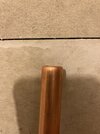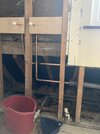Hi all,
First time giving soldering a go with copper pipe/yorkshire fittings and all ok thus far apart from one problem. I am using a pipe cutter and then am trying to use a bending spring to bend the pipe but can't insert the spring into the cut end. What I noticed is that the cutter will essentially bend the pipe inwards very slightly, but enough to impede the spring entry. I have tried using a file on the inside of the pipe but no success.
Is there a trick to doing this, or do I just have to cut them a different way (hacksaw?). I've attached a photo which probably doesn't show much but you can see where it compresses the end slightly, as well as cutting it.
Thanks
First time giving soldering a go with copper pipe/yorkshire fittings and all ok thus far apart from one problem. I am using a pipe cutter and then am trying to use a bending spring to bend the pipe but can't insert the spring into the cut end. What I noticed is that the cutter will essentially bend the pipe inwards very slightly, but enough to impede the spring entry. I have tried using a file on the inside of the pipe but no success.
Is there a trick to doing this, or do I just have to cut them a different way (hacksaw?). I've attached a photo which probably doesn't show much but you can see where it compresses the end slightly, as well as cutting it.
Thanks



